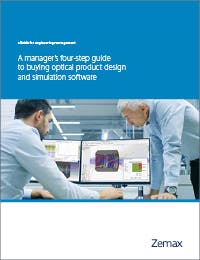Finding and implementing the right optical product design and simulation software can be the single greatest difference between hitting your product development goals and missing them. But the risks with a new software solution are high: implementation may take longer than planned, your engineers may be unhappy with the usability. Before you start down that path, make sure your team could benefit from a new solution. Here are six questions to ask:
1. Is your team as productive as it could be?
Is there confusion about when a design is good enough to go to prototyping? Are repeated cycles of design, test, and redesign causing delays? The right software should allow your team to complete a current project and move on to the next project in a timely fashion.
2. How is team morale?
Do your engineers get frustrated repeating and confirming the same design constraints? Are your engineering teams faced with a lot of back and forth that makes troubleshooting difficult and time consuming? If you’re seeing bottlenecks, the right software can minimize rework required for a product release.
3. Are you staying on budget?
Are failed prototypes causing you to go over budget? If design projects tend to run over budget, you might need a new way to identify errors in a design without having to build a physical prototype.
4. Is your software out of date?
How long does it take for new members of your team to be productive with your current design software? Does your design software include tools to support the latest design challenges in the industry? If the UI of the software is outdated, or the software lacks the ability to perform robust product simulations, you should look at better validation tools than may have been available when you purchased your current solution.
5. Are you working with a number of different solutions?
Do your teams utilize different file formats? If so, it may be complicating and slowing down the product development process. It may be time to consolidate and look for a single solution that can cover all of your optical product design needs. Managing and supporting multiple tools can have an adverse impact on your budget and the resources needed to maintain their use. Standardizing on a single solution can simplify things greatly.
6. Can your software be customized to meet your unique design needs?
Does your software fit the design needs of your team, or do team members have to adapt to the software? Does your software offer a comprehensive API? If not, your team may not be getting all the information that it needs, and it may be time for an update.
Buying optical design and analysis software: what you need to know
If you determine that your team could benefit from new optical product design and simulation software, it can be difficult to differentiate between the options on the market—especially when they all claim to be best-in-class. Let us demystify the process for you. Our free guide provides practical guidance to optical product design software buyers to identify key factors for evaluation and find the best-fit solution.


